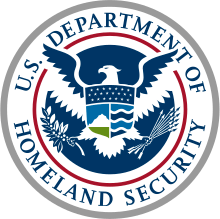Global Entry

Global Entry is a program of the U.S. Customs and Border Protection service that allows pre-approved, low-risk travelers to receive expedited clearance upon arrival into the United States. As of October 2017, Global Entry was available at 54 US airports and 15 preclearance locations.[1] More than 1.8 million people are enrolled in Global Entry and approximately 50,000 new applications for the program are filed monthly.[2]
Enrollment
To enroll in Global Entry, applicants must first file an application with Customs and Border Protection, and then submit to an interview and background check. The wait for an interview may be months.[3] There is a $100 non-refundable fee for the application, even for infants and children (some credit cards reimburse this fee).[4] During the interview, the applicant's fingerprints are captured and a digital photo is taken. Applicants are also given instructions on how to use the automated kiosk. Once an application is approved, the applicant may use the Global Entry kiosk at any participating airport for a duration of five years past one's next birthday following approval. Renewal requires an additional fee.[5]
Entry procedure

Air
Enrolled users must present their machine-readable passport or permanent residency card, and submit their fingerprints to establish identity. Users then complete a computerized customs declaration, and are issued a receipt instructing them to either proceed to baggage claim, or to a normal inspection booth for an interview.[6]
Land and Sea
Enrolled users are provided with an RFID-enabled Global Entry membership card that may be used to enter the United States via expedited NEXUS lanes from Canada, or SENTRI lanes from Mexico, or at sea ports of entry.[7]
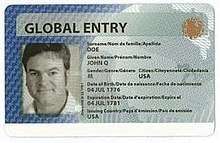
Enrollment eligibility
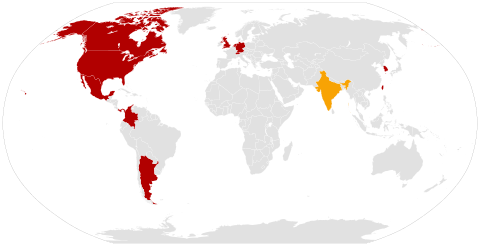
Countries currently participating in Global Entry include the following:[8]
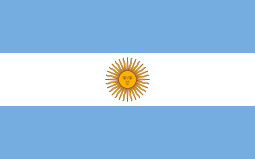

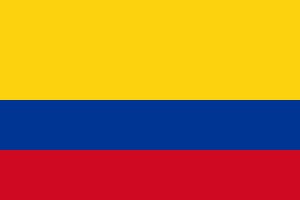


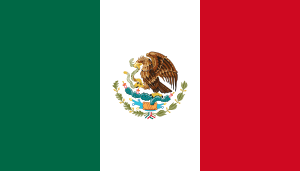







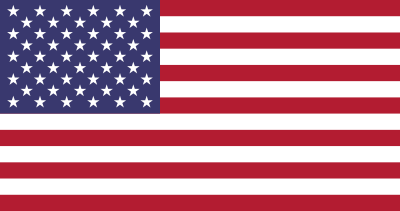
Disqualification and revocation
It is possible for any type of criminal conviction to disqualify a traveler from the Global Entry program. Three to five percent of travelers who sign up for the program are rejected; in such cases, they are generally told the reason for the rejection. For example, paying a fine for having a prohibited or undeclared item at a port of entry generally will disqualify a traveler.
Those whose Global Entry applications are denied have three ways to appeal: making an appointment to speak with a supervisor at a trusted traveler enrollment center, e-mailing the Trusted Traveler Ombudsman, or filing a complaint through the Department of Homeland Security's Traveler Redress Inquiry Program.[15]
CBP claims that in less than one percent of cases in which Global Entry was granted, it will be revoked. In these situations, an explanation for the revocation is not necessarily supplied.[16]
TSA PreCheck
Members of Global Entry (along with members of NEXUS and SENTRI) may use TSA PreCheck on all participating airlines by entering their Customs and Border Protection ID number from their Global Entry card into their flight reservation information or into their frequent flyer account under "Known Traveler Number" (KTN).
Program history
During the 1990s and early 2000s, the US Immigration and Naturalization Service operated INSPASS, a trusted traveler program designed to integrate with Canadian and European programs, at JFK and Newark Airports. INSPASS operated with a similar system, identifying travelers with their handprint. The program was discontinued in 2002 when the INS was merged with U.S. Customs to form U.S. Customs and Border Protection.[17]
The Global Entry program was initially deployed at a small number of airports, including New York-JFK (Terminal 4), Washington-Dulles and Houston-Intercontinental. Following a good reception by travelers, the program was expanded to include Los Angeles International, Atlanta-Hartsfield, Chicago-O'Hare and Miami International Airport.
In May 2009, Global Entry membership was expanded to include Netherlands citizens who are also members of the Dutch Privium trusted traveler program under the FLUX (Fast Low-risk Universal Crossing) alliance. Present members of Global Entry are now permitted to apply to join the Privium program at Amsterdam-Schiphol International Airport allowing entry into the Schengen area. Members of NEXUS and SENTRI are also entitled to use Global Entry.[4]
Participants may enter the United States (or the United States pre-clearance area in select international airports) by utilizing automated kiosks located at the following airports:[18]
- Abu Dhabi International Airport (AUH)*
- Anchorage – Ted Stevens Anchorage International Airport (ANC)
- Atlanta – Hartsfield-Jackson Atlanta International Airport (ATL)
- Austin-Bergstrom International Airport (AUS)
- Baltimore/Washington International Thurgood Marshall Airport (BWI)
- Boston – Logan International Airport (BOS)
- Burlington International Airport (BTV)*
- Calgary International Airport (YYC)
- Charlotte-Douglas International Airport (CLT)
- Chicago Midway International Airport (MDW)*
- Chicago O'Hare International Airport (ORD)
- Cincinnati/Northern Kentucky International Airport (CVG)
- Cleveland Hopkins International Airport (CLE)
- Dallas/Fort Worth International Airport (DFW)
- Daniel K. Inouye International Airport (HNL)
- Denver International Airport (DEN)
- Detroit Metropolitan Airport (DTW)
- Dublin Airport (DUB)*
- Edmonton International Airport (YEG)
- Fairbanks International Airport (FAI)
- Fort Lauderdale/Hollywood International Airport (FLL)
- General Mitchell International Airport, Milwaukee (MKE)
- Guam International Airport (GUM)
- Halifax Stanfield International Airport (YHZ)
- Houston George Bush Intercontinental Airport (IAH)
- John F. Kennedy International Airport, New York City (JFK)
- John Wayne Airport (SNA)*
- Lambert-St. Louis International Airport (STL)
- Los Angeles International Airport (LAX)
- McCarran International Airport, Las Vegas (LAS)
- Miami International Airport (MIA)
- Minneapolis/St. Paul International Airport (MSP)
- Montréal–Pierre Elliott Trudeau International Airport (YUL)
- Newark Liberty International Airport (EWR)
- Oakland International Airport (OAK)*
- Orlando International Airport (MCO)
- Orlando-Sanford International Airport (SFB)
- Ottawa Macdonald-Cartier International Airport (YOW)
- Philadelphia International Airport (PHL)
- Phoenix Sky Harbor International Airport (PHX)
- Pittsburgh International Airport (PIT)
- Portland International Airport (PDX)
- Queen Beatrix International Airport, Aruba (AUA)*
- Raleigh-Durham International Airport (RDU)*
- Saipan International Airport (SPN)*
- Salt Lake City International Airport (SLC)
- San Antonio International Airport (SAT)
- San Diego International Airport (SAN)
- San Francisco International Airport (SFO)
- San Jose International Airport (SJC)*
- San Juan Luis Muñoz Marin International Airport (SJU)
- Seattle-Tacoma International Airport – SeaTac (SEA)
- Shannon Airport (SNN)*
- Lynden Pindling International Airport, Bahamas (NAS)*
- Tampa International Airport (TPA)
- Toronto Pearson International Airport (YYZ)
- Vancouver International Airport (YVR)
- Washington-Dulles International Airport (IAD)
- Winnipeg James Armstrong Richardson International Airport (YWG)
The * indicates there are no enrollment centers at these sites.
Analogous systems in other countries
The Australian and New Zealand SmartGate system is available to all holders of biometric passports of Australia, Canada, France, Ireland, New Zealand, Singapore, Sweden, the UK, and the USA aged 16 or over. Citizens of Switzerland over 16 years of age can use SmartGate facilities at 8 Australian Airports. It requires no pre-registration and is similar to its US counterpart, although in addition, it uses facial recognition technology to process passengers.
Germany's federal police also offers Easypass automated border control at major airports, such as Frankfurt. It recently started a pilot called ABG+ with GlobalEntry.[19]
In Hong Kong, the e-Channel is situated at all border crossing points. A person who holds a Hong Kong Identity Card (HKID) inserts the card into a slot to enter the first gate and then has their thumbprint scanned to pass through the second gate.[20]
The Japanese equivalent to the US program, Automated gate, cost is 2200 JPY in the form of revenue stamps. It is similar in that a passport and fingerprint are scanned at a kiosk to pass.[21]
Mexico's Viajero Confiable program is open to Mexican citizens and US citizens who are members of Global Entry and are permanent residents of Mexico [22]. Prospective members must pass a background check, interview with a Mexican immigration officer, and have fingerprints and iris scans taken. Kiosks are currently available at the Cancun, Los Cabos, and Mexico City international airports, but the Mexican government hopes to expand it to other cities in the near future.[23]
Taiwan's e-Gate is a free automated entry system for citizens and certain classes of residents and frequent visitors. Users simply scan their travel documents at the gate and are passed through for facial recognition. Electronic fingerprinting is used when facial recognition fails. Registration is available at the immigration counter right at the port of entry.[24]
In Korea, Smart Entry Service is the automated immigration clearance system. Korean citizens aged 7 or above, all foreigners residing in Korea aged 17 or above, US citizens aged 17 or above who are not residing in Korea and participating in Global Entry, and Hong Kong and Macau electronic passport holders aged 17 or above are eligible for the programme. Korean citizens who registered their fingerprints are exempted from pre-registration. US dual citizens holding Korean citizenship must use their Korean passports to use the programme. US citizens with a valid Korean visa must use their Alien Registration Card to participate in the programme and are exempted from the Global Entry prerequisite. It uses both facial recognition and fingerprinting technology. [25]
See also
References
- 1 2 "Taiwan joins US Global Entry travel program". AIT.
- 1 2 "CBP Announces Reciprocal Arrangement with Germany for Trusted Traveler Programs". U.S. Customs and Border Protection. December 29, 2014.
- ↑ Hamm, Catharine M. (May 29, 2013). "Almost a 'Trusted Traveler': Are the airport hassles behind her now?l". Los Angeles Times. Retrieved February 2, 2016.
- 1 2 "How to Apply for Global Entry". U.S. Customs and Border Protection. Retrieved December 3, 2015.
- ↑ "Global Entry Frequently Asked Questions". GlobalEntry.gov.
- ↑ "How to Use the Kiosk". CBP. Archived from the original on June 25, 2009.
- ↑ "Global Entry Card". US Customs and Border Protection. Retrieved 26 August 2018.
- ↑ "Eligibility for Global Entry". U.S. Customs and Border Protection.
- ↑ "Paso a paso: cómo funciona el sistema Global Entry para ingresar a los Estados Unidos". Retrieved August 4, 2016.
- ↑ "Expedited entry into US for Indian travellers from now on - Times of India". The Times of India. Retrieved June 28, 2017.
- ↑ https://insideflyer.nl/registered-traveller-program-nederland-maakt-global-entry-toegankelijk/
- ↑ "Faster immigration clearance for eligible Singaporeans travelling to US". www.channelnewsasia.com. Retrieved July 6, 2016.
- ↑ "Global Entry Program: 10 steps to accessing the U.S. Global Entry Program". Retrieved March 26, 2017.
- ↑ "CBP Announces the Expansion of Global Entry to UK Citizens". U.S. Customs and Border Protection. November 3, 2015.
- ↑ Stellin, Stella (October 8, 2012). "Frustrating Hurdle at Customs". The New York Times.
- ↑ Kugel, Seth (April 24, 2014). "Global Entry and Company: Worth the Price?". The New York Times.
- ↑ http://www.globalsecurity.org/security/systems/inspass.htm USPASS (formerly INSPASS)
- ↑ "Airports with Global Entry Kiosks". U.S. Customs and Border Protection.
- ↑ "ABG+ with GlobalEntry". Germany.info.
- ↑ "e-Channel". IMMD.gov.hk.
- ↑ (PDF) http://www.immi-moj.go.jp/ttp2/en/pdf/info.pdf. Missing or empty
|title=(help) - ↑ "Viajero Confiable". GOB.mx.
- ↑ "Viajero Confiable Locations". GOB.mx.
- ↑ "e-Gate". immigration.gov.tw.
- ↑ "Smart Entry Service". ses.go.kr.
External links
- U.S. Customs and Border Patrol – Global Entry Trusted Traveler Program

